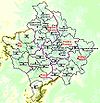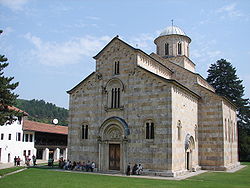- Dečani
-
This article is about the city and municipality in Kosovo. For the architectural term, see Decani.
Dečani — Municipality — Dečani/Дечани
DeçanLocation in Kosovo Coordinates: 42°32′N 20°17′E / 42.533°N 20.283°ECoordinates: 42°32′N 20°17′E / 42.533°N 20.283°E Country Kosovo[a] District District of Peć Municipalities Municipality of Dečani Government – Mayor Rasim Selmanaj Area – Total 180 km2 (69.5 sq mi) Population (2011) – Total 38,984 (municipality) – Density 132.6/km2 (343.4/sq mi) Time zone CET (UTC+1) – Summer (DST) CEST (UTC+2) Postal code 51000 Area code(s) 0381 390 Car plates 03 Website Municipality of Dečani Dečani or Deçan (Albanian: Deçan or Dečani; Serbian: Дечани, Dečani, pronounced [dɛ̌t͡ʃani]) is a town and Municipality in the Peć district of western Kosovo.[a]. It is a mountainous area which borders Montenegro and Albania. There is a total of 36 villages within the municipality[1]. The territory of the municipality is 371 km2.
During the 1998-1999 conflict, Dečani was one of the strongholds of the Kosovo Liberation Army (KLA) and subsequently suffered a large amount of infrastructure destruction by the Serbian military and paramilitary forces. Much reconstruction has taken place with the assistance of the international agencies and support from the Kosovo Albanian diaspora.[citation needed] It is widely known for the Visoki Dečani monastery of the Serbian Orthodox Church.
Contents
Demographics
In 2011, the population of the municipality numbered 38,984. "Others" includes Bosniaks, Kosovo Ashkalia, Egyptians and Roma. The non-Albanian communities mainly reside in the villages of Babaloc, Dubovik, Gramocelj, Irznic, Požar, Rastavica, Šaptelj, Papracane. There are Serbian Orthodox clergy in the Visoki Dečani monastery.
Visoki Dečani monastery
Main article: Visoki DečaniThe Serbian Orthodox monastery Visoki Dečani near the town is 36 meters by 24 meters with a tower 29 meters high. It was built between 1327 and 1335 by the Serbian medieval king, St. Stephen of Dečani, and was dedicated to the Ascension of the Lord. The monastery is situated in the valley of the Dečanska Bistrica river surrounded by the mountains and forests of the Prokletije mountain range. It is regarded as the largest and best preserved medieval monastery in Kosovo. The founding charter of the monastery is dated 1330. The following year the Stefan Uroš III died and was buried at the monastery, which henceforth became his popular shrine. Indeed, the epithet Dečanski refers to geographical location of the king's foundation of the monastery. Construction was continued by his son Emperor Stefan Uroš IV Dušan until 1335, but the wall-painting was not completed until 1350.
The monastic church, dedicated to Christ Pantocrator and built from blocks of red-purple, light-yellow and onyx marble, was constructed by builders working under a Franciscan monk, Vitus of Kotor. The church is distinguished by its imposing size and Romanesque and Early Gothic structure and design. Apart from the extensive and well preserved fresco cycles the interior features the original 14th-century stone templon, the throne of the hegumen and the carved wooden sarcophagus of the founder King Stefan.
On the "The Crucifixion" fresco, painted in 1350, objects similar to UFOs can be found. They represent two comets and in recent times have been taken to bear a resemblance to generic space ships, with two men inside of them, and they are often quoted by Ufologists.
Visoki Dečani was declared a Monument of Culture of Exceptional Importance in 1990, and was protected by the former Federal Republic of Yugoslavia. In 2004, UNESCO listed the monastery on the World Heritage List, citing its frescoes as "one of the most valued examples of the so-called Palaeologan renaissance in Byzantine painting" and "a valuable record of the life in the 14th century" and was protected by UNMIK/KFOR.
During its turbulent history the monastery was an important spiritual center renowned for its artistic and intellectual activities. Although the monastery buildings suffered damage during the Ottoman period, the church has been completely preserved complete with its 14th century fresco paintings. Today a young brotherhood of 30 brethren lives in the monastery maintaining the traditions of the past: religious services, icon painting, wood carving, book publishing and is also active in the missionary work. The beautiful monastic services are served according to the typicon of Mount Athos.
In 2004, UNESCO listed the monastery on the World Heritage List, citing its frescoes as "one of the most valued examples of the so-called Palaeologan renaissance in Byzantine painting" and "a valuable record of the life in the 14th century".
Villages of the Municipality of Dečani
List of settlements:[1]
- Rastavica (Rastavica)
- Babaloć (Baballoq)
- Gornji Crnobreg (Carrabreg i Epërm)
- Donji Crnobreg (Carrabreg i Poshtem)
- Donji Streoc (Strellc i Poshtem)
- Gornji Streoc (Strellc i Epërm)
- Drenovce (Drenoc)
- Dubovik (Dubovik)
- Gramočelj (Gramaçel)
- Huljaj (Hulaj)
- Jasić (Jasiq)
- Junik (Junik)
- Kodralija (Kodrali)
- Ljubuša (Lëbushë)
- Locan (Lloqan)
- Bistrica (Lumbardh)
- Maznik (Maznik)
- Papić (Papiq)
- Pepša (Pepsh)
- Požar (Posar)
- Prilep (Prilep)
- Gornji Ratiš (Ratish i Epërm)
- Rznić (Rrzniq)
- Šaptej (Shaptej)
- Slup (Sllup)
- Vokša (Voksh)
- Mali Vranovac (Vranoc i Vogël)
Mountains
See Also
- Dečani monastery
- UNESCO World Heritage Site
- Visoki Dečani monastery
- District of Đakovica
Notes
Notes:
a. ^ Kosovo is the subject of a territorial dispute between the Republic of Serbia and the self-proclaimed Republic of Kosovo. The latter declared independence on 17 February 2008, while Serbia claims it as part of its own sovereign territory. Its independence is recognised by 85 UN member states. External links
- Municipality of Dečani - official site
- OSCE Municipal Profile of Deçan / Dečani
- Visoki Dečani Monastery, Serbian Orthodox Church
- BBC World radio documentary - heritage: the balkans
References
- ^ http://earth-info.nga.mil/gns/html/namefiles.htm GNS Name Database
- OSCE Organization for Security and Co-operation in Europe: mik/2005/02/1181_en.pdf
- PTK - Post and Telecommunictions of Kosovo, J.S.C:KodePostare.pdf
- ENKEO Electronic Network of Kosovar Environmental Organization: decani.pdf
- IFLA - International Federation of Library Associations and Institutions: kosorepo.htm#_Toc480784381
Kosovo Dečani • Đakovica • Dragaš • Glogovac • Gnjilane • Istok • Kačanik • Klina • Kosovo Polje • Kosovska Kamenica • Kosovska Mitrovica • Leposavić • Lipljan • Mališevo • Novo Brdo • Obilić • Orahovac • Peć • Podujevo • Priština • Prizren • Štimlje • Srbica • Štrpce • Suva Reka • Uroševac • Vitina • Vučitrn • Zubin Potok • Zvečan New Municipalities: Đeneral Janković • Gračanica • Junik • Klokot-Vrbovac • Mamuša • Parteš • RanilugPlanned Municipality: North Kosovska MitrovicaCategories:
New Municipalities: Đeneral Janković • Gračanica • Junik • Klokot-Vrbovac • Mamuša • Parteš • RanilugPlanned Municipality: North Kosovska MitrovicaCategories:- Municipalities of Kosovo
- Populated places in Kosovo
- Prokletije Mountains
Wikimedia Foundation. 2010.


